Business and Business Environment: Types, Scope, and Functions Report
VerifiedAdded on 2023/01/11
|12
|3823
|22
Report
AI Summary
This report provides a comprehensive analysis of the business and business environment, encompassing various types of organizations such as public, private, and voluntary sectors. It explores their purposes, sizes, and scopes, highlighting the key differences and operational characteristics of each. The report further delves into the interrelationship between organizational functions, objectives, and structure, emphasizing how these elements contribute to overall business performance and goal attainment. Examples of companies like HSBC and IKEA are used to illustrate the concepts discussed. The report also discusses the scope of public, private and voluntary companies with their functional differences. The report concludes with a discussion on the interrelationship between company objectives, functions, and structure.
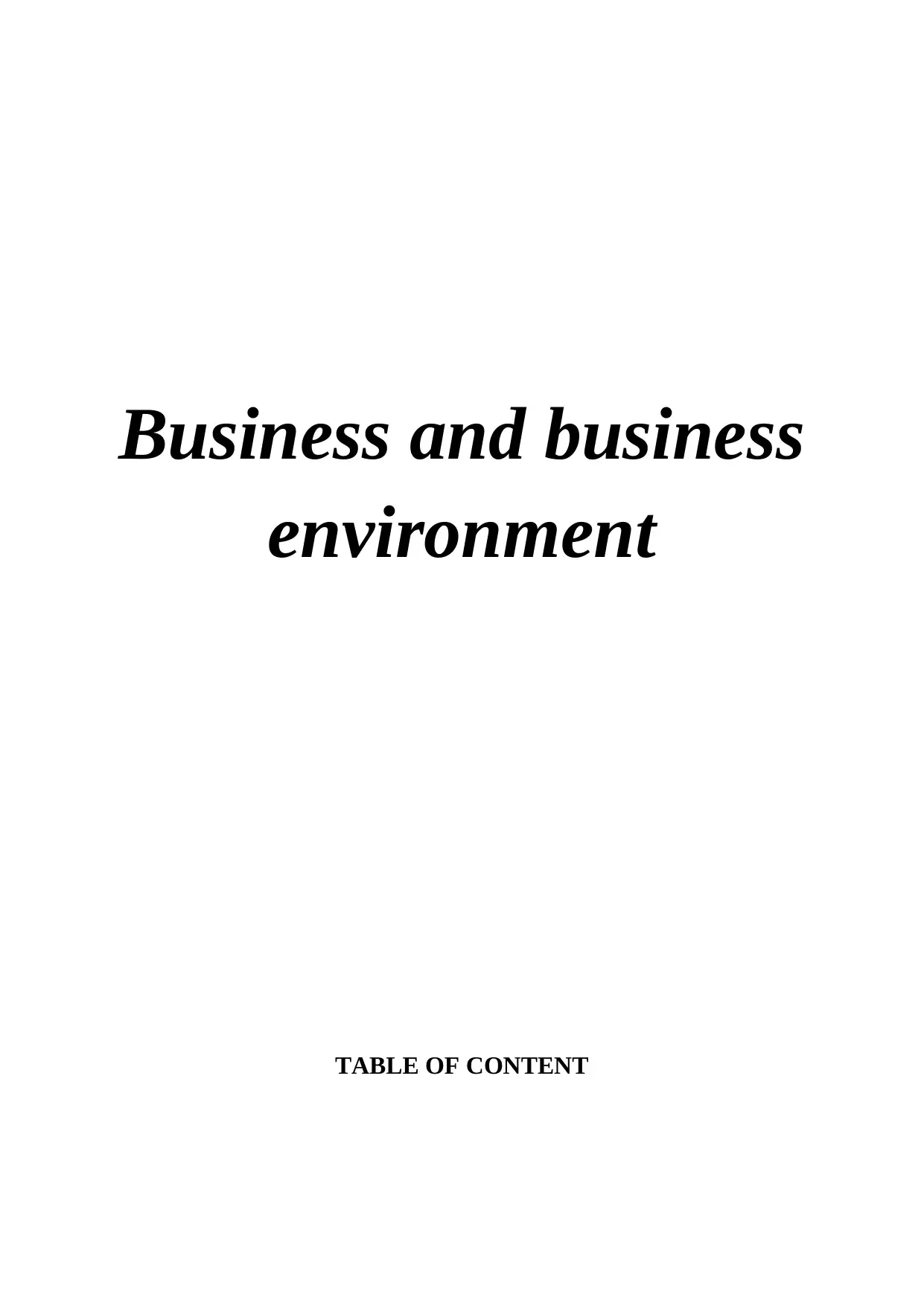
Business and business
environment
TABLE OF CONTENT
environment
TABLE OF CONTENT
Paraphrase This Document
Need a fresh take? Get an instant paraphrase of this document with our AI Paraphraser
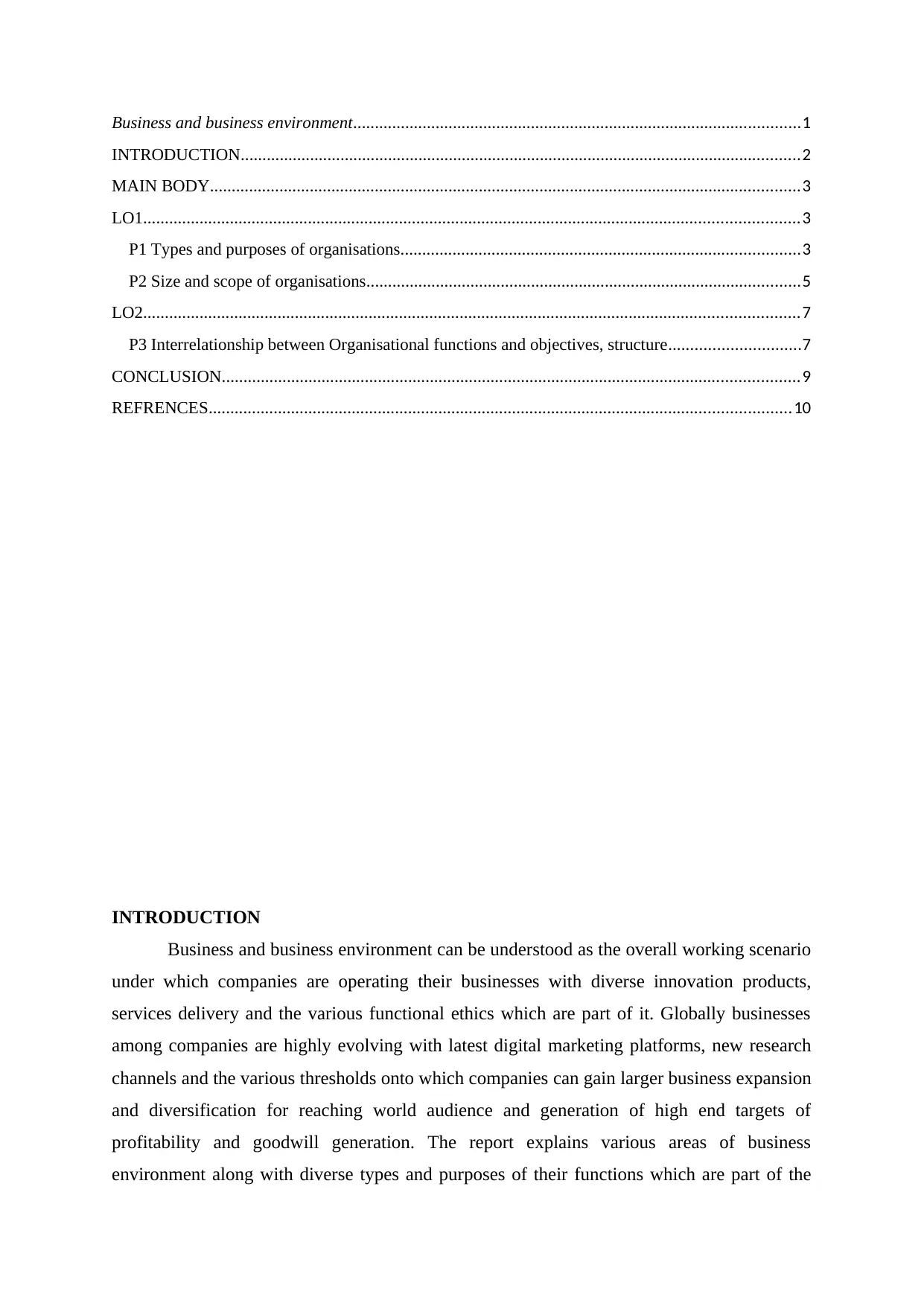
Business and business environment.......................................................................................................1
INTRODUCTION.................................................................................................................................2
MAIN BODY........................................................................................................................................3
LO1.......................................................................................................................................................3
P1 Types and purposes of organisations............................................................................................3
P2 Size and scope of organisations....................................................................................................5
LO2.......................................................................................................................................................7
P3 Interrelationship between Organisational functions and objectives, structure..............................7
CONCLUSION.....................................................................................................................................9
REFRENCES......................................................................................................................................10
INTRODUCTION
Business and business environment can be understood as the overall working scenario
under which companies are operating their businesses with diverse innovation products,
services delivery and the various functional ethics which are part of it. Globally businesses
among companies are highly evolving with latest digital marketing platforms, new research
channels and the various thresholds onto which companies can gain larger business expansion
and diversification for reaching world audience and generation of high end targets of
profitability and goodwill generation. The report explains various areas of business
environment along with diverse types and purposes of their functions which are part of the
INTRODUCTION.................................................................................................................................2
MAIN BODY........................................................................................................................................3
LO1.......................................................................................................................................................3
P1 Types and purposes of organisations............................................................................................3
P2 Size and scope of organisations....................................................................................................5
LO2.......................................................................................................................................................7
P3 Interrelationship between Organisational functions and objectives, structure..............................7
CONCLUSION.....................................................................................................................................9
REFRENCES......................................................................................................................................10
INTRODUCTION
Business and business environment can be understood as the overall working scenario
under which companies are operating their businesses with diverse innovation products,
services delivery and the various functional ethics which are part of it. Globally businesses
among companies are highly evolving with latest digital marketing platforms, new research
channels and the various thresholds onto which companies can gain larger business expansion
and diversification for reaching world audience and generation of high end targets of
profitability and goodwill generation. The report explains various areas of business
environment along with diverse types and purposes of their functions which are part of the
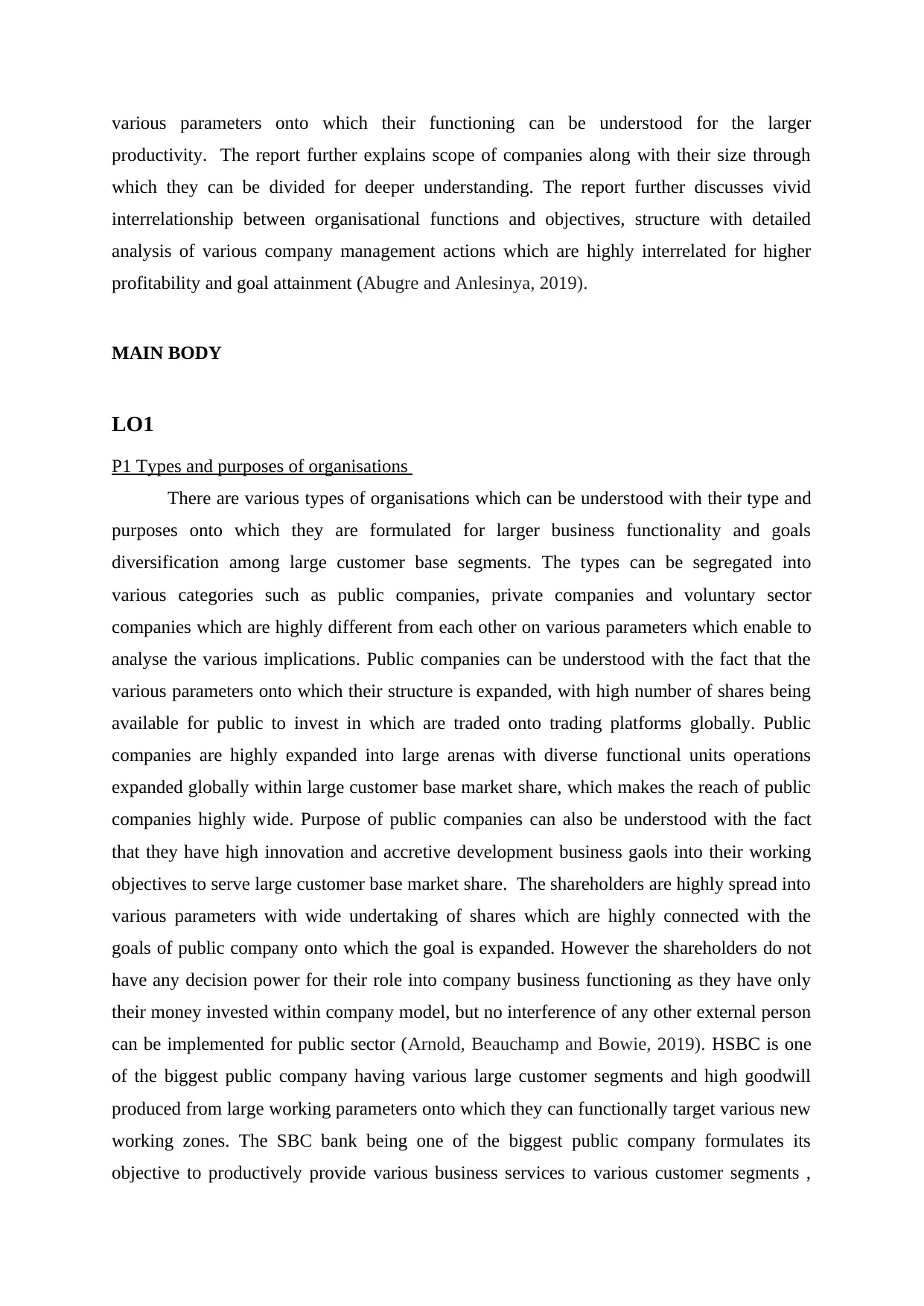
various parameters onto which their functioning can be understood for the larger
productivity. The report further explains scope of companies along with their size through
which they can be divided for deeper understanding. The report further discusses vivid
interrelationship between organisational functions and objectives, structure with detailed
analysis of various company management actions which are highly interrelated for higher
profitability and goal attainment (Abugre and Anlesinya, 2019).
MAIN BODY
LO1
P1 Types and purposes of organisations
There are various types of organisations which can be understood with their type and
purposes onto which they are formulated for larger business functionality and goals
diversification among large customer base segments. The types can be segregated into
various categories such as public companies, private companies and voluntary sector
companies which are highly different from each other on various parameters which enable to
analyse the various implications. Public companies can be understood with the fact that the
various parameters onto which their structure is expanded, with high number of shares being
available for public to invest in which are traded onto trading platforms globally. Public
companies are highly expanded into large arenas with diverse functional units operations
expanded globally within large customer base market share, which makes the reach of public
companies highly wide. Purpose of public companies can also be understood with the fact
that they have high innovation and accretive development business gaols into their working
objectives to serve large customer base market share. The shareholders are highly spread into
various parameters with wide undertaking of shares which are highly connected with the
goals of public company onto which the goal is expanded. However the shareholders do not
have any decision power for their role into company business functioning as they have only
their money invested within company model, but no interference of any other external person
can be implemented for public sector (Arnold, Beauchamp and Bowie, 2019). HSBC is one
of the biggest public company having various large customer segments and high goodwill
produced from large working parameters onto which they can functionally target various new
working zones. The SBC bank being one of the biggest public company formulates its
objective to productively provide various business services to various customer segments ,
productivity. The report further explains scope of companies along with their size through
which they can be divided for deeper understanding. The report further discusses vivid
interrelationship between organisational functions and objectives, structure with detailed
analysis of various company management actions which are highly interrelated for higher
profitability and goal attainment (Abugre and Anlesinya, 2019).
MAIN BODY
LO1
P1 Types and purposes of organisations
There are various types of organisations which can be understood with their type and
purposes onto which they are formulated for larger business functionality and goals
diversification among large customer base segments. The types can be segregated into
various categories such as public companies, private companies and voluntary sector
companies which are highly different from each other on various parameters which enable to
analyse the various implications. Public companies can be understood with the fact that the
various parameters onto which their structure is expanded, with high number of shares being
available for public to invest in which are traded onto trading platforms globally. Public
companies are highly expanded into large arenas with diverse functional units operations
expanded globally within large customer base market share, which makes the reach of public
companies highly wide. Purpose of public companies can also be understood with the fact
that they have high innovation and accretive development business gaols into their working
objectives to serve large customer base market share. The shareholders are highly spread into
various parameters with wide undertaking of shares which are highly connected with the
goals of public company onto which the goal is expanded. However the shareholders do not
have any decision power for their role into company business functioning as they have only
their money invested within company model, but no interference of any other external person
can be implemented for public sector (Arnold, Beauchamp and Bowie, 2019). HSBC is one
of the biggest public company having various large customer segments and high goodwill
produced from large working parameters onto which they can functionally target various new
working zones. The SBC bank being one of the biggest public company formulates its
objective to productively provide various business services to various customer segments ,
⊘ This is a preview!⊘
Do you want full access?
Subscribe today to unlock all pages.

Trusted by 1+ million students worldwide
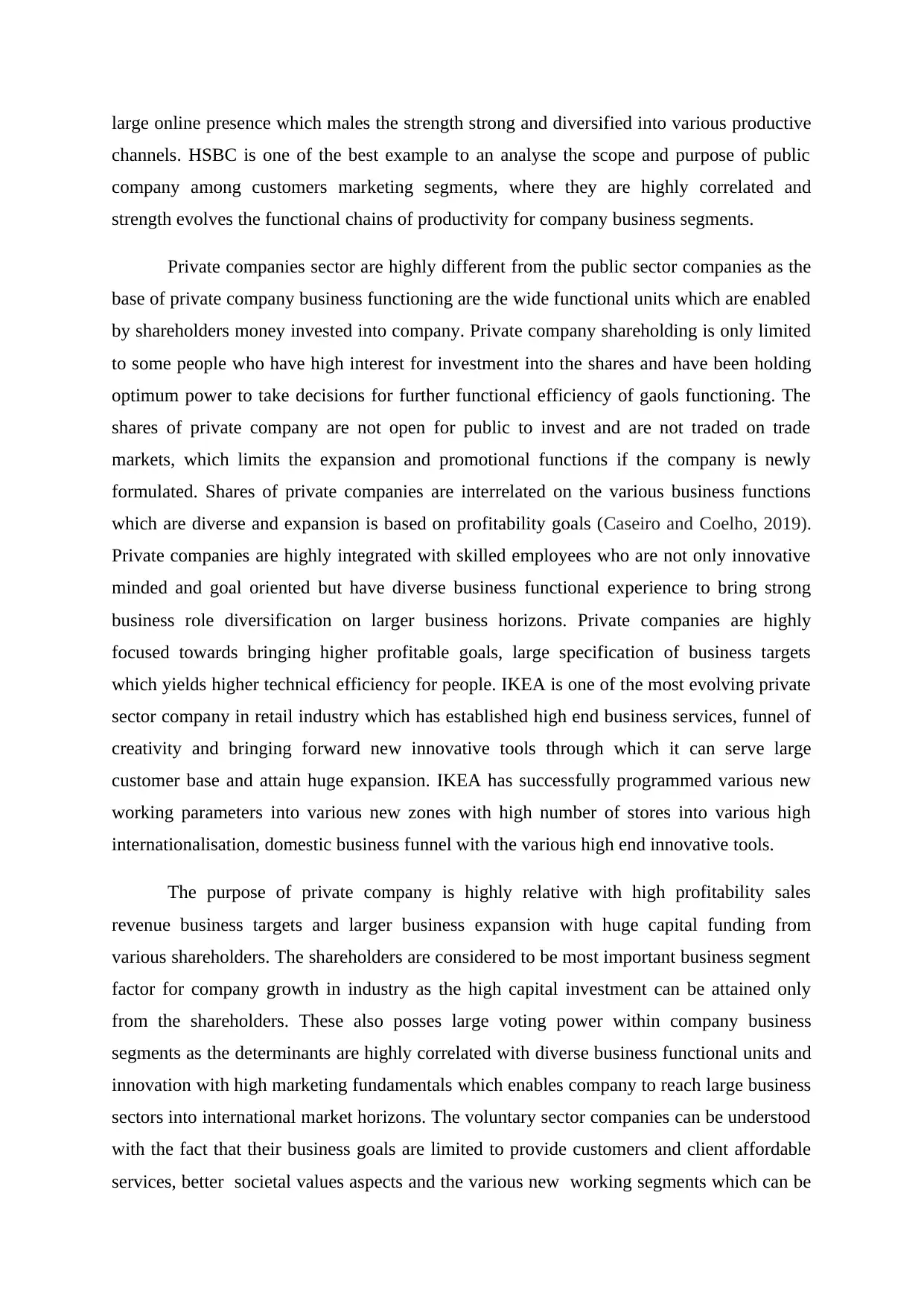
large online presence which males the strength strong and diversified into various productive
channels. HSBC is one of the best example to an analyse the scope and purpose of public
company among customers marketing segments, where they are highly correlated and
strength evolves the functional chains of productivity for company business segments.
Private companies sector are highly different from the public sector companies as the
base of private company business functioning are the wide functional units which are enabled
by shareholders money invested into company. Private company shareholding is only limited
to some people who have high interest for investment into the shares and have been holding
optimum power to take decisions for further functional efficiency of gaols functioning. The
shares of private company are not open for public to invest and are not traded on trade
markets, which limits the expansion and promotional functions if the company is newly
formulated. Shares of private companies are interrelated on the various business functions
which are diverse and expansion is based on profitability goals (Caseiro and Coelho, 2019).
Private companies are highly integrated with skilled employees who are not only innovative
minded and goal oriented but have diverse business functional experience to bring strong
business role diversification on larger business horizons. Private companies are highly
focused towards bringing higher profitable goals, large specification of business targets
which yields higher technical efficiency for people. IKEA is one of the most evolving private
sector company in retail industry which has established high end business services, funnel of
creativity and bringing forward new innovative tools through which it can serve large
customer base and attain huge expansion. IKEA has successfully programmed various new
working parameters into various new zones with high number of stores into various high
internationalisation, domestic business funnel with the various high end innovative tools.
The purpose of private company is highly relative with high profitability sales
revenue business targets and larger business expansion with huge capital funding from
various shareholders. The shareholders are considered to be most important business segment
factor for company growth in industry as the high capital investment can be attained only
from the shareholders. These also posses large voting power within company business
segments as the determinants are highly correlated with diverse business functional units and
innovation with high marketing fundamentals which enables company to reach large business
sectors into international market horizons. The voluntary sector companies can be understood
with the fact that their business goals are limited to provide customers and client affordable
services, better societal values aspects and the various new working segments which can be
channels. HSBC is one of the best example to an analyse the scope and purpose of public
company among customers marketing segments, where they are highly correlated and
strength evolves the functional chains of productivity for company business segments.
Private companies sector are highly different from the public sector companies as the
base of private company business functioning are the wide functional units which are enabled
by shareholders money invested into company. Private company shareholding is only limited
to some people who have high interest for investment into the shares and have been holding
optimum power to take decisions for further functional efficiency of gaols functioning. The
shares of private company are not open for public to invest and are not traded on trade
markets, which limits the expansion and promotional functions if the company is newly
formulated. Shares of private companies are interrelated on the various business functions
which are diverse and expansion is based on profitability goals (Caseiro and Coelho, 2019).
Private companies are highly integrated with skilled employees who are not only innovative
minded and goal oriented but have diverse business functional experience to bring strong
business role diversification on larger business horizons. Private companies are highly
focused towards bringing higher profitable goals, large specification of business targets
which yields higher technical efficiency for people. IKEA is one of the most evolving private
sector company in retail industry which has established high end business services, funnel of
creativity and bringing forward new innovative tools through which it can serve large
customer base and attain huge expansion. IKEA has successfully programmed various new
working parameters into various new zones with high number of stores into various high
internationalisation, domestic business funnel with the various high end innovative tools.
The purpose of private company is highly relative with high profitability sales
revenue business targets and larger business expansion with huge capital funding from
various shareholders. The shareholders are considered to be most important business segment
factor for company growth in industry as the high capital investment can be attained only
from the shareholders. These also posses large voting power within company business
segments as the determinants are highly correlated with diverse business functional units and
innovation with high marketing fundamentals which enables company to reach large business
sectors into international market horizons. The voluntary sector companies can be understood
with the fact that their business goals are limited to provide customers and client affordable
services, better societal values aspects and the various new working segments which can be
Paraphrase This Document
Need a fresh take? Get an instant paraphrase of this document with our AI Paraphraser
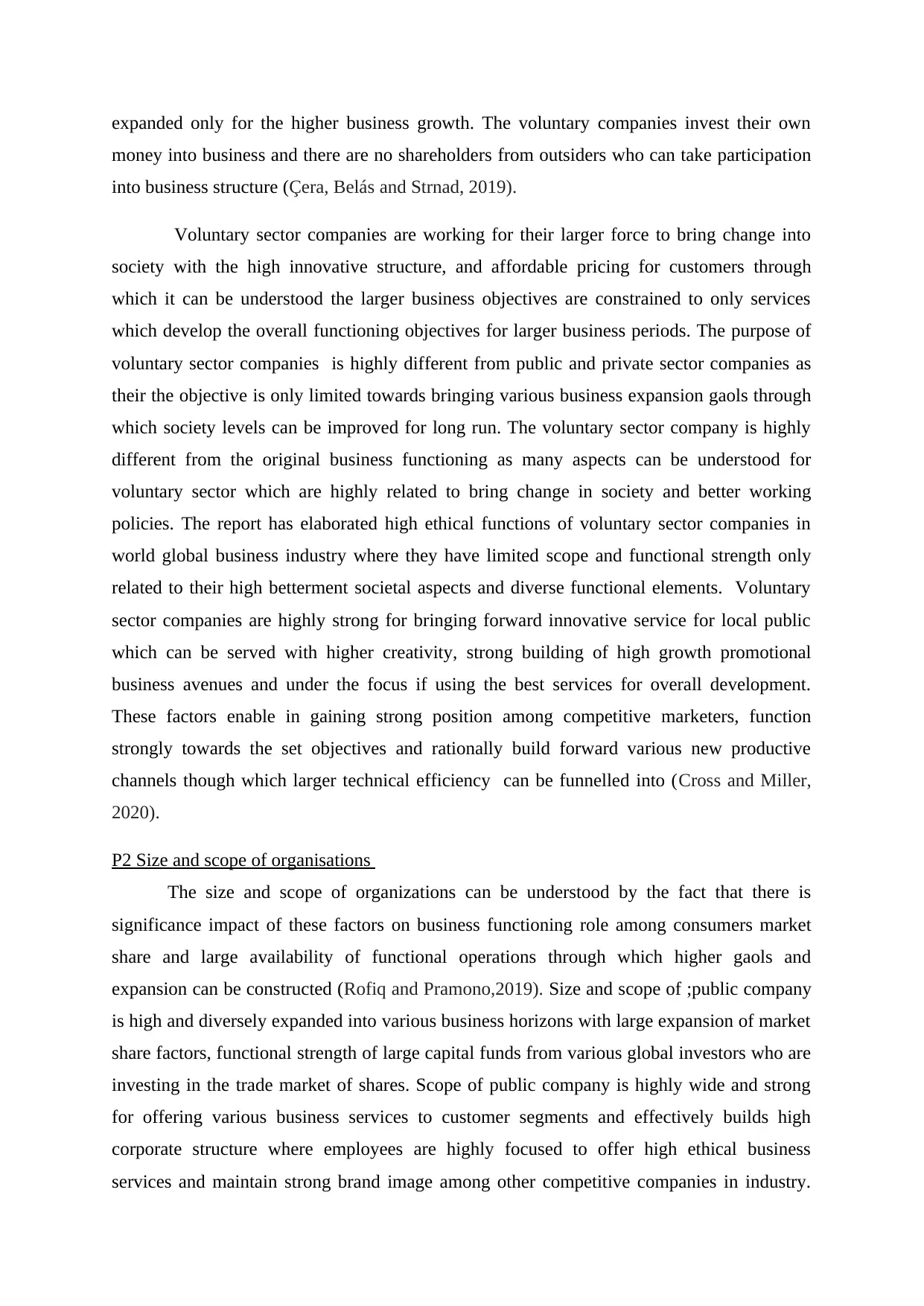
expanded only for the higher business growth. The voluntary companies invest their own
money into business and there are no shareholders from outsiders who can take participation
into business structure (Çera, Belás and Strnad, 2019).
Voluntary sector companies are working for their larger force to bring change into
society with the high innovative structure, and affordable pricing for customers through
which it can be understood the larger business objectives are constrained to only services
which develop the overall functioning objectives for larger business periods. The purpose of
voluntary sector companies is highly different from public and private sector companies as
their the objective is only limited towards bringing various business expansion gaols through
which society levels can be improved for long run. The voluntary sector company is highly
different from the original business functioning as many aspects can be understood for
voluntary sector which are highly related to bring change in society and better working
policies. The report has elaborated high ethical functions of voluntary sector companies in
world global business industry where they have limited scope and functional strength only
related to their high betterment societal aspects and diverse functional elements. Voluntary
sector companies are highly strong for bringing forward innovative service for local public
which can be served with higher creativity, strong building of high growth promotional
business avenues and under the focus if using the best services for overall development.
These factors enable in gaining strong position among competitive marketers, function
strongly towards the set objectives and rationally build forward various new productive
channels though which larger technical efficiency can be funnelled into (Cross and Miller,
2020).
P2 Size and scope of organisations
The size and scope of organizations can be understood by the fact that there is
significance impact of these factors on business functioning role among consumers market
share and large availability of functional operations through which higher gaols and
expansion can be constructed (Rofiq and Pramono,2019). Size and scope of ;public company
is high and diversely expanded into various business horizons with large expansion of market
share factors, functional strength of large capital funds from various global investors who are
investing in the trade market of shares. Scope of public company is highly wide and strong
for offering various business services to customer segments and effectively builds high
corporate structure where employees are highly focused to offer high ethical business
services and maintain strong brand image among other competitive companies in industry.
money into business and there are no shareholders from outsiders who can take participation
into business structure (Çera, Belás and Strnad, 2019).
Voluntary sector companies are working for their larger force to bring change into
society with the high innovative structure, and affordable pricing for customers through
which it can be understood the larger business objectives are constrained to only services
which develop the overall functioning objectives for larger business periods. The purpose of
voluntary sector companies is highly different from public and private sector companies as
their the objective is only limited towards bringing various business expansion gaols through
which society levels can be improved for long run. The voluntary sector company is highly
different from the original business functioning as many aspects can be understood for
voluntary sector which are highly related to bring change in society and better working
policies. The report has elaborated high ethical functions of voluntary sector companies in
world global business industry where they have limited scope and functional strength only
related to their high betterment societal aspects and diverse functional elements. Voluntary
sector companies are highly strong for bringing forward innovative service for local public
which can be served with higher creativity, strong building of high growth promotional
business avenues and under the focus if using the best services for overall development.
These factors enable in gaining strong position among competitive marketers, function
strongly towards the set objectives and rationally build forward various new productive
channels though which larger technical efficiency can be funnelled into (Cross and Miller,
2020).
P2 Size and scope of organisations
The size and scope of organizations can be understood by the fact that there is
significance impact of these factors on business functioning role among consumers market
share and large availability of functional operations through which higher gaols and
expansion can be constructed (Rofiq and Pramono,2019). Size and scope of ;public company
is high and diversely expanded into various business horizons with large expansion of market
share factors, functional strength of large capital funds from various global investors who are
investing in the trade market of shares. Scope of public company is highly wide and strong
for offering various business services to customer segments and effectively builds high
corporate structure where employees are highly focused to offer high ethical business
services and maintain strong brand image among other competitive companies in industry.
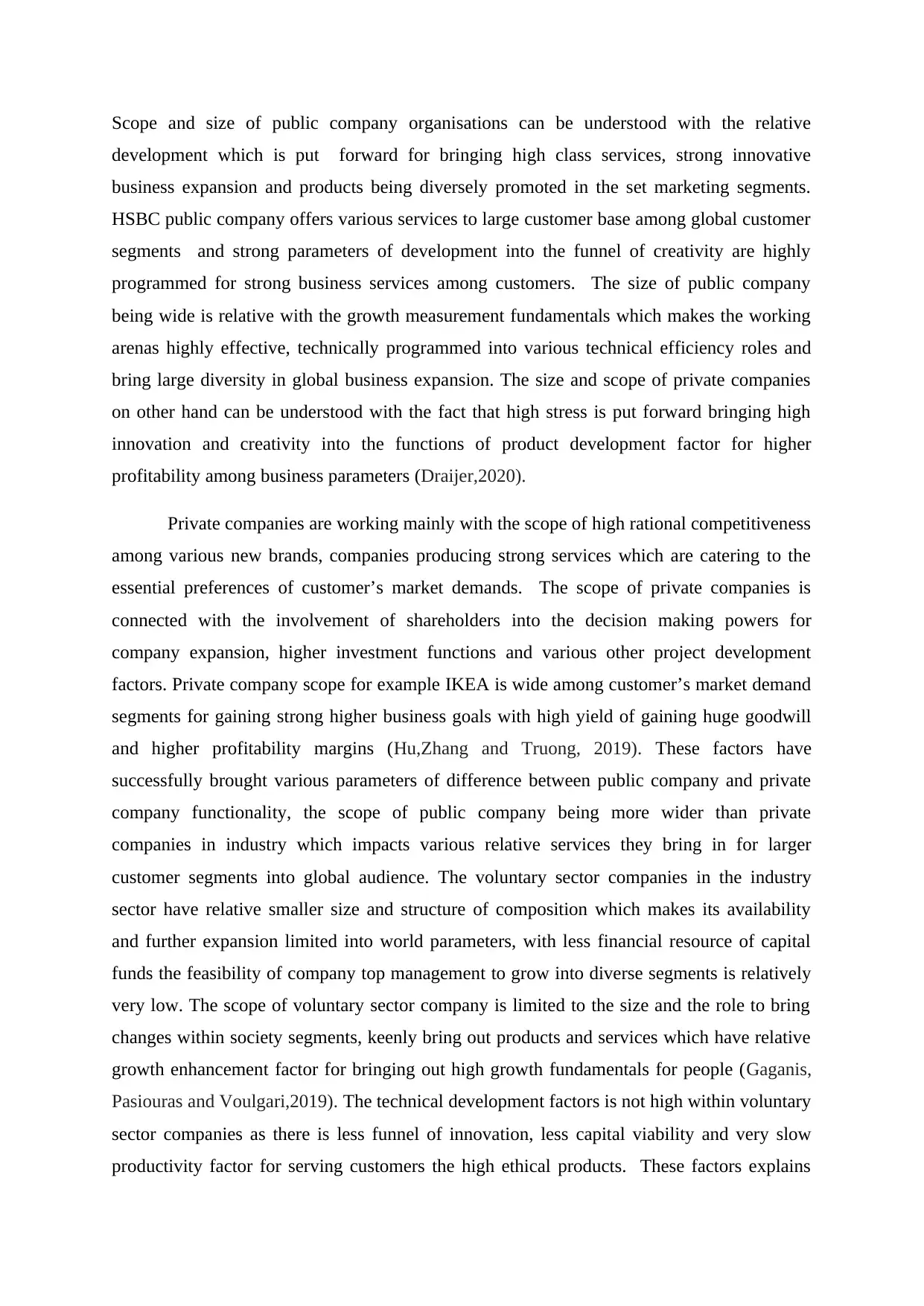
Scope and size of public company organisations can be understood with the relative
development which is put forward for bringing high class services, strong innovative
business expansion and products being diversely promoted in the set marketing segments.
HSBC public company offers various services to large customer base among global customer
segments and strong parameters of development into the funnel of creativity are highly
programmed for strong business services among customers. The size of public company
being wide is relative with the growth measurement fundamentals which makes the working
arenas highly effective, technically programmed into various technical efficiency roles and
bring large diversity in global business expansion. The size and scope of private companies
on other hand can be understood with the fact that high stress is put forward bringing high
innovation and creativity into the functions of product development factor for higher
profitability among business parameters (Draijer,2020).
Private companies are working mainly with the scope of high rational competitiveness
among various new brands, companies producing strong services which are catering to the
essential preferences of customer’s market demands. The scope of private companies is
connected with the involvement of shareholders into the decision making powers for
company expansion, higher investment functions and various other project development
factors. Private company scope for example IKEA is wide among customer’s market demand
segments for gaining strong higher business goals with high yield of gaining huge goodwill
and higher profitability margins (Hu,Zhang and Truong, 2019). These factors have
successfully brought various parameters of difference between public company and private
company functionality, the scope of public company being more wider than private
companies in industry which impacts various relative services they bring in for larger
customer segments into global audience. The voluntary sector companies in the industry
sector have relative smaller size and structure of composition which makes its availability
and further expansion limited into world parameters, with less financial resource of capital
funds the feasibility of company top management to grow into diverse segments is relatively
very low. The scope of voluntary sector company is limited to the size and the role to bring
changes within society segments, keenly bring out products and services which have relative
growth enhancement factor for bringing out high growth fundamentals for people (Gaganis,
Pasiouras and Voulgari,2019). The technical development factors is not high within voluntary
sector companies as there is less funnel of innovation, less capital viability and very slow
productivity factor for serving customers the high ethical products. These factors explains
development which is put forward for bringing high class services, strong innovative
business expansion and products being diversely promoted in the set marketing segments.
HSBC public company offers various services to large customer base among global customer
segments and strong parameters of development into the funnel of creativity are highly
programmed for strong business services among customers. The size of public company
being wide is relative with the growth measurement fundamentals which makes the working
arenas highly effective, technically programmed into various technical efficiency roles and
bring large diversity in global business expansion. The size and scope of private companies
on other hand can be understood with the fact that high stress is put forward bringing high
innovation and creativity into the functions of product development factor for higher
profitability among business parameters (Draijer,2020).
Private companies are working mainly with the scope of high rational competitiveness
among various new brands, companies producing strong services which are catering to the
essential preferences of customer’s market demands. The scope of private companies is
connected with the involvement of shareholders into the decision making powers for
company expansion, higher investment functions and various other project development
factors. Private company scope for example IKEA is wide among customer’s market demand
segments for gaining strong higher business goals with high yield of gaining huge goodwill
and higher profitability margins (Hu,Zhang and Truong, 2019). These factors have
successfully brought various parameters of difference between public company and private
company functionality, the scope of public company being more wider than private
companies in industry which impacts various relative services they bring in for larger
customer segments into global audience. The voluntary sector companies in the industry
sector have relative smaller size and structure of composition which makes its availability
and further expansion limited into world parameters, with less financial resource of capital
funds the feasibility of company top management to grow into diverse segments is relatively
very low. The scope of voluntary sector company is limited to the size and the role to bring
changes within society segments, keenly bring out products and services which have relative
growth enhancement factor for bringing out high growth fundamentals for people (Gaganis,
Pasiouras and Voulgari,2019). The technical development factors is not high within voluntary
sector companies as there is less funnel of innovation, less capital viability and very slow
productivity factor for serving customers the high ethical products. These factors explains
⊘ This is a preview!⊘
Do you want full access?
Subscribe today to unlock all pages.

Trusted by 1+ million students worldwide
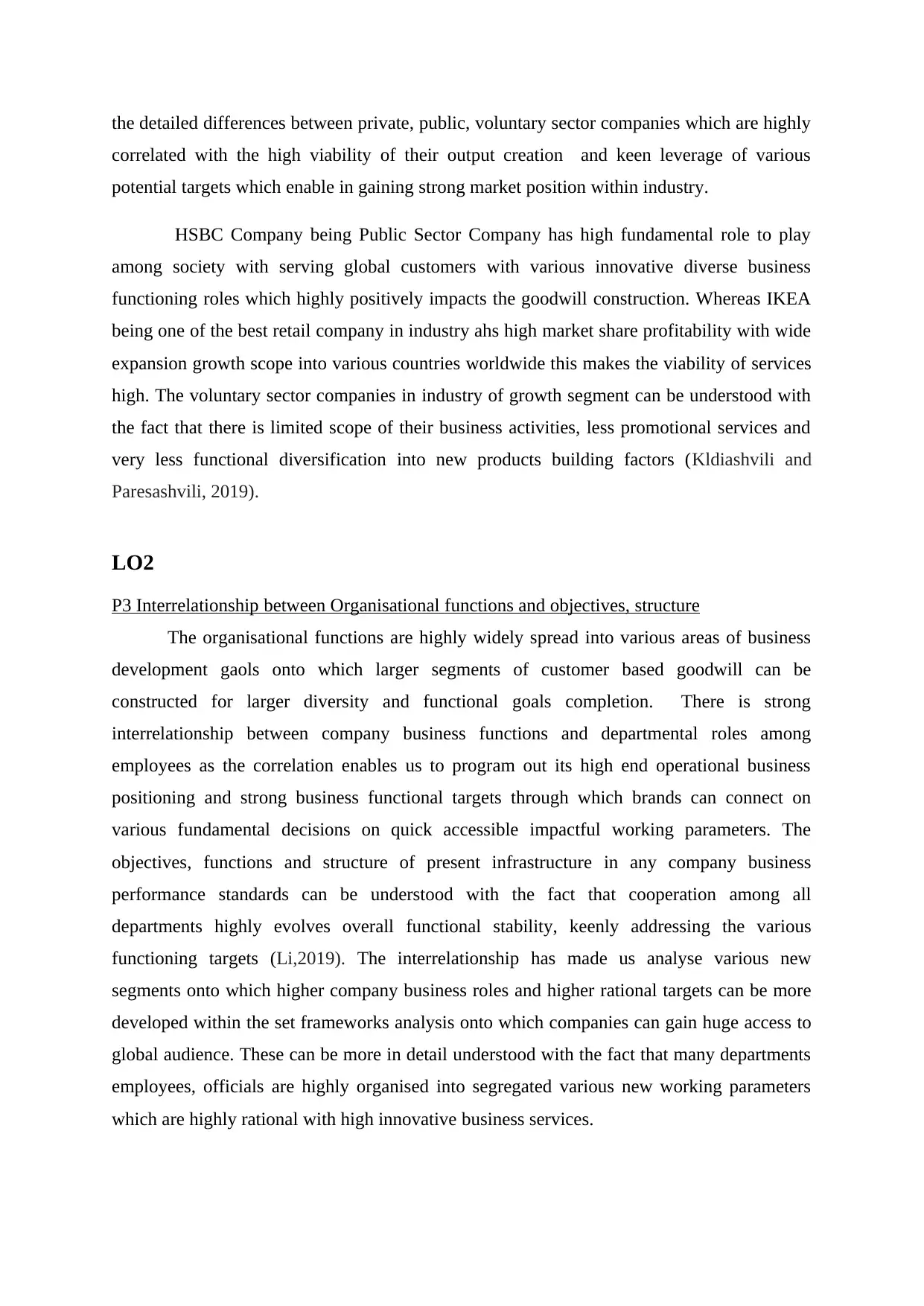
the detailed differences between private, public, voluntary sector companies which are highly
correlated with the high viability of their output creation and keen leverage of various
potential targets which enable in gaining strong market position within industry.
HSBC Company being Public Sector Company has high fundamental role to play
among society with serving global customers with various innovative diverse business
functioning roles which highly positively impacts the goodwill construction. Whereas IKEA
being one of the best retail company in industry ahs high market share profitability with wide
expansion growth scope into various countries worldwide this makes the viability of services
high. The voluntary sector companies in industry of growth segment can be understood with
the fact that there is limited scope of their business activities, less promotional services and
very less functional diversification into new products building factors (Kldiashvili and
Paresashvili, 2019).
LO2
P3 Interrelationship between Organisational functions and objectives, structure
The organisational functions are highly widely spread into various areas of business
development gaols onto which larger segments of customer based goodwill can be
constructed for larger diversity and functional goals completion. There is strong
interrelationship between company business functions and departmental roles among
employees as the correlation enables us to program out its high end operational business
positioning and strong business functional targets through which brands can connect on
various fundamental decisions on quick accessible impactful working parameters. The
objectives, functions and structure of present infrastructure in any company business
performance standards can be understood with the fact that cooperation among all
departments highly evolves overall functional stability, keenly addressing the various
functioning targets (Li,2019). The interrelationship has made us analyse various new
segments onto which higher company business roles and higher rational targets can be more
developed within the set frameworks analysis onto which companies can gain huge access to
global audience. These can be more in detail understood with the fact that many departments
employees, officials are highly organised into segregated various new working parameters
which are highly rational with high innovative business services.
correlated with the high viability of their output creation and keen leverage of various
potential targets which enable in gaining strong market position within industry.
HSBC Company being Public Sector Company has high fundamental role to play
among society with serving global customers with various innovative diverse business
functioning roles which highly positively impacts the goodwill construction. Whereas IKEA
being one of the best retail company in industry ahs high market share profitability with wide
expansion growth scope into various countries worldwide this makes the viability of services
high. The voluntary sector companies in industry of growth segment can be understood with
the fact that there is limited scope of their business activities, less promotional services and
very less functional diversification into new products building factors (Kldiashvili and
Paresashvili, 2019).
LO2
P3 Interrelationship between Organisational functions and objectives, structure
The organisational functions are highly widely spread into various areas of business
development gaols onto which larger segments of customer based goodwill can be
constructed for larger diversity and functional goals completion. There is strong
interrelationship between company business functions and departmental roles among
employees as the correlation enables us to program out its high end operational business
positioning and strong business functional targets through which brands can connect on
various fundamental decisions on quick accessible impactful working parameters. The
objectives, functions and structure of present infrastructure in any company business
performance standards can be understood with the fact that cooperation among all
departments highly evolves overall functional stability, keenly addressing the various
functioning targets (Li,2019). The interrelationship has made us analyse various new
segments onto which higher company business roles and higher rational targets can be more
developed within the set frameworks analysis onto which companies can gain huge access to
global audience. These can be more in detail understood with the fact that many departments
employees, officials are highly organised into segregated various new working parameters
which are highly rational with high innovative business services.
Paraphrase This Document
Need a fresh take? Get an instant paraphrase of this document with our AI Paraphraser
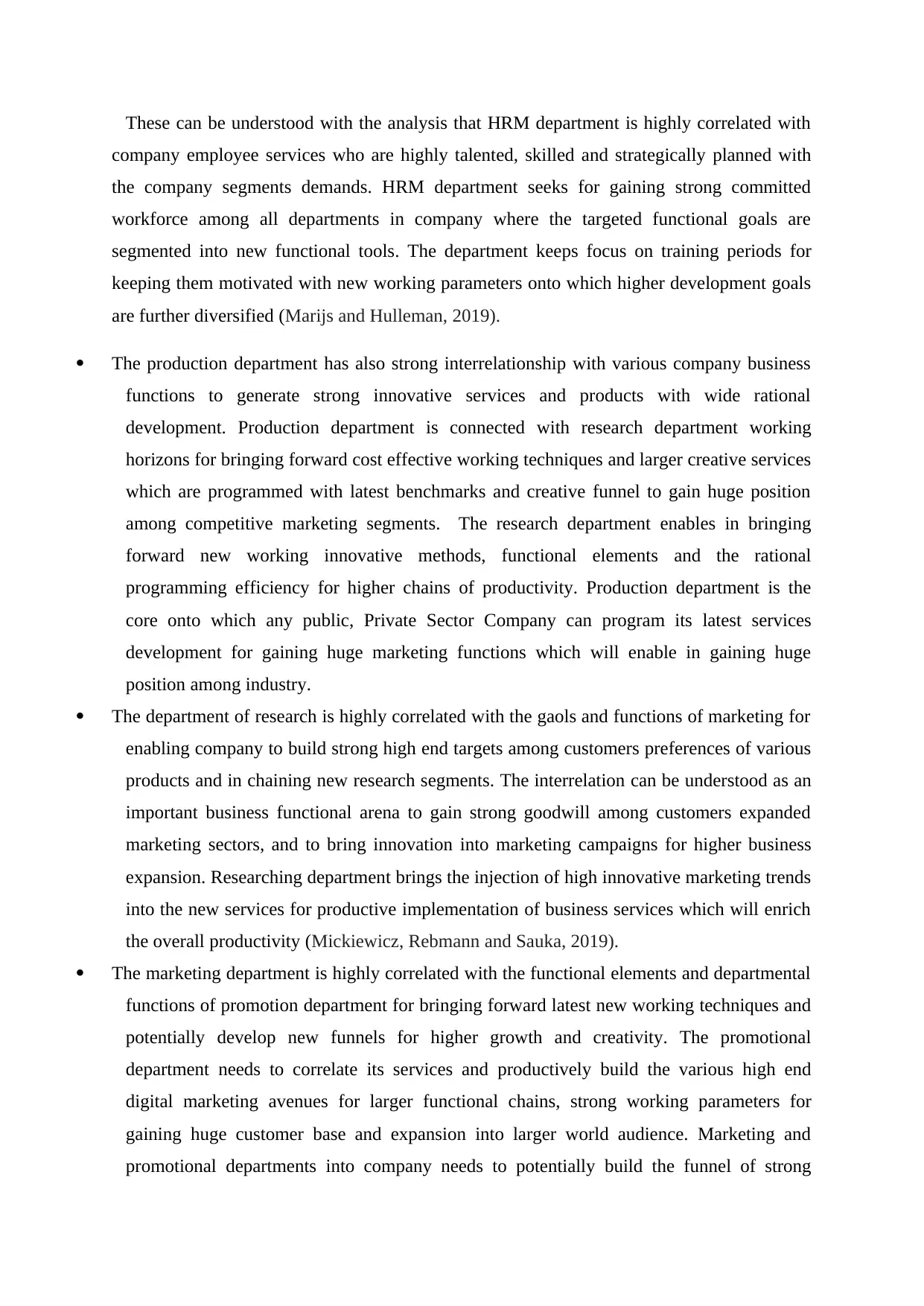
These can be understood with the analysis that HRM department is highly correlated with
company employee services who are highly talented, skilled and strategically planned with
the company segments demands. HRM department seeks for gaining strong committed
workforce among all departments in company where the targeted functional goals are
segmented into new functional tools. The department keeps focus on training periods for
keeping them motivated with new working parameters onto which higher development goals
are further diversified (Marijs and Hulleman, 2019).
The production department has also strong interrelationship with various company business
functions to generate strong innovative services and products with wide rational
development. Production department is connected with research department working
horizons for bringing forward cost effective working techniques and larger creative services
which are programmed with latest benchmarks and creative funnel to gain huge position
among competitive marketing segments. The research department enables in bringing
forward new working innovative methods, functional elements and the rational
programming efficiency for higher chains of productivity. Production department is the
core onto which any public, Private Sector Company can program its latest services
development for gaining huge marketing functions which will enable in gaining huge
position among industry.
The department of research is highly correlated with the gaols and functions of marketing for
enabling company to build strong high end targets among customers preferences of various
products and in chaining new research segments. The interrelation can be understood as an
important business functional arena to gain strong goodwill among customers expanded
marketing sectors, and to bring innovation into marketing campaigns for higher business
expansion. Researching department brings the injection of high innovative marketing trends
into the new services for productive implementation of business services which will enrich
the overall productivity (Mickiewicz, Rebmann and Sauka, 2019).
The marketing department is highly correlated with the functional elements and departmental
functions of promotion department for bringing forward latest new working techniques and
potentially develop new funnels for higher growth and creativity. The promotional
department needs to correlate its services and productively build the various high end
digital marketing avenues for larger functional chains, strong working parameters for
gaining huge customer base and expansion into larger world audience. Marketing and
promotional departments into company needs to potentially build the funnel of strong
company employee services who are highly talented, skilled and strategically planned with
the company segments demands. HRM department seeks for gaining strong committed
workforce among all departments in company where the targeted functional goals are
segmented into new functional tools. The department keeps focus on training periods for
keeping them motivated with new working parameters onto which higher development goals
are further diversified (Marijs and Hulleman, 2019).
The production department has also strong interrelationship with various company business
functions to generate strong innovative services and products with wide rational
development. Production department is connected with research department working
horizons for bringing forward cost effective working techniques and larger creative services
which are programmed with latest benchmarks and creative funnel to gain huge position
among competitive marketing segments. The research department enables in bringing
forward new working innovative methods, functional elements and the rational
programming efficiency for higher chains of productivity. Production department is the
core onto which any public, Private Sector Company can program its latest services
development for gaining huge marketing functions which will enable in gaining huge
position among industry.
The department of research is highly correlated with the gaols and functions of marketing for
enabling company to build strong high end targets among customers preferences of various
products and in chaining new research segments. The interrelation can be understood as an
important business functional arena to gain strong goodwill among customers expanded
marketing sectors, and to bring innovation into marketing campaigns for higher business
expansion. Researching department brings the injection of high innovative marketing trends
into the new services for productive implementation of business services which will enrich
the overall productivity (Mickiewicz, Rebmann and Sauka, 2019).
The marketing department is highly correlated with the functional elements and departmental
functions of promotion department for bringing forward latest new working techniques and
potentially develop new funnels for higher growth and creativity. The promotional
department needs to correlate its services and productively build the various high end
digital marketing avenues for larger functional chains, strong working parameters for
gaining huge customer base and expansion into larger world audience. Marketing and
promotional departments into company needs to potentially build the funnel of strong
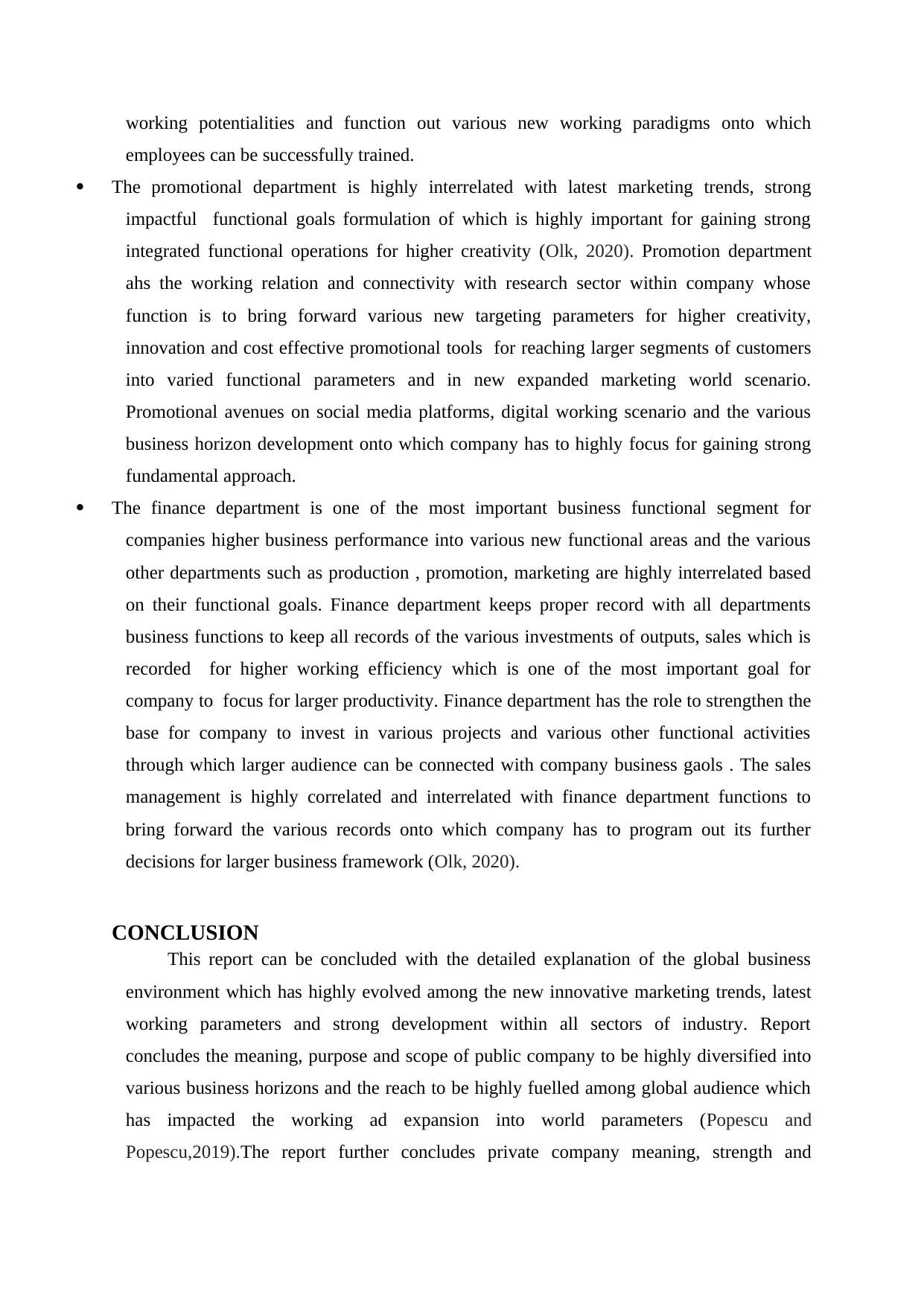
working potentialities and function out various new working paradigms onto which
employees can be successfully trained.
The promotional department is highly interrelated with latest marketing trends, strong
impactful functional goals formulation of which is highly important for gaining strong
integrated functional operations for higher creativity (Olk, 2020). Promotion department
ahs the working relation and connectivity with research sector within company whose
function is to bring forward various new targeting parameters for higher creativity,
innovation and cost effective promotional tools for reaching larger segments of customers
into varied functional parameters and in new expanded marketing world scenario.
Promotional avenues on social media platforms, digital working scenario and the various
business horizon development onto which company has to highly focus for gaining strong
fundamental approach.
The finance department is one of the most important business functional segment for
companies higher business performance into various new functional areas and the various
other departments such as production , promotion, marketing are highly interrelated based
on their functional goals. Finance department keeps proper record with all departments
business functions to keep all records of the various investments of outputs, sales which is
recorded for higher working efficiency which is one of the most important goal for
company to focus for larger productivity. Finance department has the role to strengthen the
base for company to invest in various projects and various other functional activities
through which larger audience can be connected with company business gaols . The sales
management is highly correlated and interrelated with finance department functions to
bring forward the various records onto which company has to program out its further
decisions for larger business framework (Olk, 2020).
CONCLUSION
This report can be concluded with the detailed explanation of the global business
environment which has highly evolved among the new innovative marketing trends, latest
working parameters and strong development within all sectors of industry. Report
concludes the meaning, purpose and scope of public company to be highly diversified into
various business horizons and the reach to be highly fuelled among global audience which
has impacted the working ad expansion into world parameters (Popescu and
Popescu,2019).The report further concludes private company meaning, strength and
employees can be successfully trained.
The promotional department is highly interrelated with latest marketing trends, strong
impactful functional goals formulation of which is highly important for gaining strong
integrated functional operations for higher creativity (Olk, 2020). Promotion department
ahs the working relation and connectivity with research sector within company whose
function is to bring forward various new targeting parameters for higher creativity,
innovation and cost effective promotional tools for reaching larger segments of customers
into varied functional parameters and in new expanded marketing world scenario.
Promotional avenues on social media platforms, digital working scenario and the various
business horizon development onto which company has to highly focus for gaining strong
fundamental approach.
The finance department is one of the most important business functional segment for
companies higher business performance into various new functional areas and the various
other departments such as production , promotion, marketing are highly interrelated based
on their functional goals. Finance department keeps proper record with all departments
business functions to keep all records of the various investments of outputs, sales which is
recorded for higher working efficiency which is one of the most important goal for
company to focus for larger productivity. Finance department has the role to strengthen the
base for company to invest in various projects and various other functional activities
through which larger audience can be connected with company business gaols . The sales
management is highly correlated and interrelated with finance department functions to
bring forward the various records onto which company has to program out its further
decisions for larger business framework (Olk, 2020).
CONCLUSION
This report can be concluded with the detailed explanation of the global business
environment which has highly evolved among the new innovative marketing trends, latest
working parameters and strong development within all sectors of industry. Report
concludes the meaning, purpose and scope of public company to be highly diversified into
various business horizons and the reach to be highly fuelled among global audience which
has impacted the working ad expansion into world parameters (Popescu and
Popescu,2019).The report further concludes private company meaning, strength and
⊘ This is a preview!⊘
Do you want full access?
Subscribe today to unlock all pages.

Trusted by 1+ million students worldwide
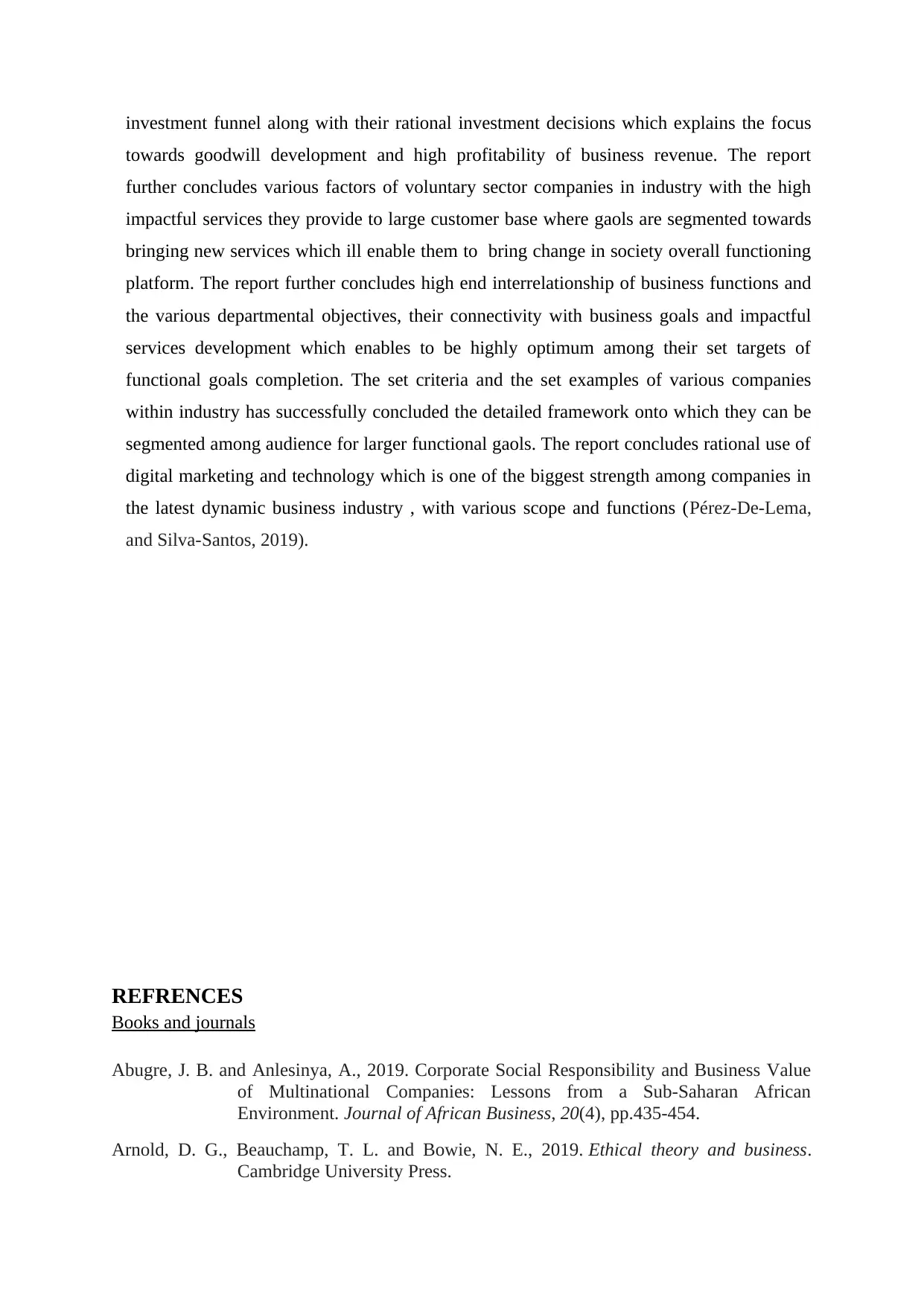
investment funnel along with their rational investment decisions which explains the focus
towards goodwill development and high profitability of business revenue. The report
further concludes various factors of voluntary sector companies in industry with the high
impactful services they provide to large customer base where gaols are segmented towards
bringing new services which ill enable them to bring change in society overall functioning
platform. The report further concludes high end interrelationship of business functions and
the various departmental objectives, their connectivity with business goals and impactful
services development which enables to be highly optimum among their set targets of
functional goals completion. The set criteria and the set examples of various companies
within industry has successfully concluded the detailed framework onto which they can be
segmented among audience for larger functional gaols. The report concludes rational use of
digital marketing and technology which is one of the biggest strength among companies in
the latest dynamic business industry , with various scope and functions (Pérez-De-Lema,
and Silva-Santos, 2019).
REFRENCES
Books and journals
Abugre, J. B. and Anlesinya, A., 2019. Corporate Social Responsibility and Business Value
of Multinational Companies: Lessons from a Sub-Saharan African
Environment. Journal of African Business, 20(4), pp.435-454.
Arnold, D. G., Beauchamp, T. L. and Bowie, N. E., 2019. Ethical theory and business.
Cambridge University Press.
towards goodwill development and high profitability of business revenue. The report
further concludes various factors of voluntary sector companies in industry with the high
impactful services they provide to large customer base where gaols are segmented towards
bringing new services which ill enable them to bring change in society overall functioning
platform. The report further concludes high end interrelationship of business functions and
the various departmental objectives, their connectivity with business goals and impactful
services development which enables to be highly optimum among their set targets of
functional goals completion. The set criteria and the set examples of various companies
within industry has successfully concluded the detailed framework onto which they can be
segmented among audience for larger functional gaols. The report concludes rational use of
digital marketing and technology which is one of the biggest strength among companies in
the latest dynamic business industry , with various scope and functions (Pérez-De-Lema,
and Silva-Santos, 2019).
REFRENCES
Books and journals
Abugre, J. B. and Anlesinya, A., 2019. Corporate Social Responsibility and Business Value
of Multinational Companies: Lessons from a Sub-Saharan African
Environment. Journal of African Business, 20(4), pp.435-454.
Arnold, D. G., Beauchamp, T. L. and Bowie, N. E., 2019. Ethical theory and business.
Cambridge University Press.
Paraphrase This Document
Need a fresh take? Get an instant paraphrase of this document with our AI Paraphraser
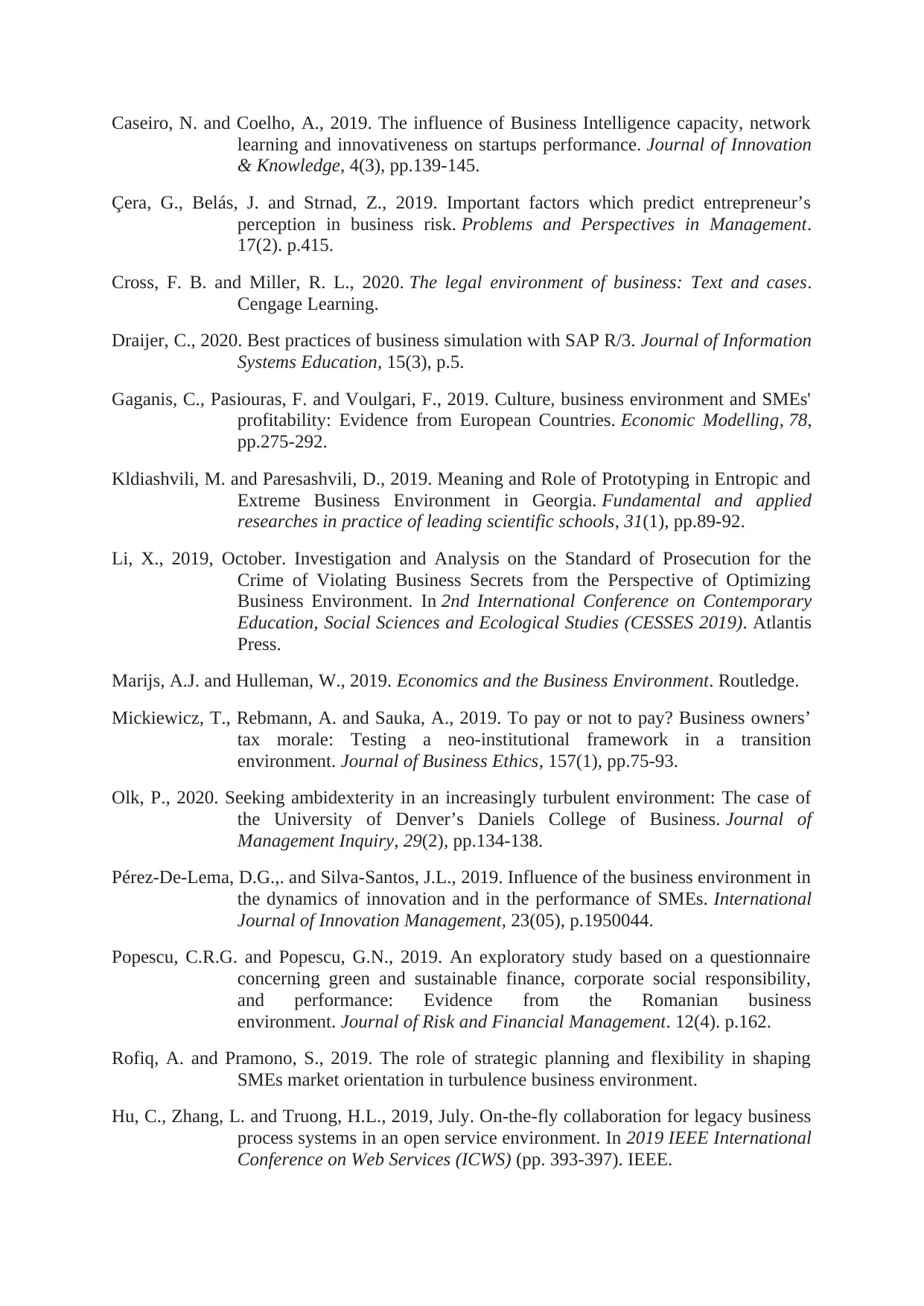
Caseiro, N. and Coelho, A., 2019. The influence of Business Intelligence capacity, network
learning and innovativeness on startups performance. Journal of Innovation
& Knowledge, 4(3), pp.139-145.
Çera, G., Belás, J. and Strnad, Z., 2019. Important factors which predict entrepreneur’s
perception in business risk. Problems and Perspectives in Management.
17(2). p.415.
Cross, F. B. and Miller, R. L., 2020. The legal environment of business: Text and cases.
Cengage Learning.
Draijer, C., 2020. Best practices of business simulation with SAP R/3. Journal of Information
Systems Education, 15(3), p.5.
Gaganis, C., Pasiouras, F. and Voulgari, F., 2019. Culture, business environment and SMEs'
profitability: Evidence from European Countries. Economic Modelling, 78,
pp.275-292.
Kldiashvili, M. and Paresashvili, D., 2019. Meaning and Role of Prototyping in Entropic and
Extreme Business Environment in Georgia. Fundamental and applied
researches in practice of leading scientific schools, 31(1), pp.89-92.
Li, X., 2019, October. Investigation and Analysis on the Standard of Prosecution for the
Crime of Violating Business Secrets from the Perspective of Optimizing
Business Environment. In 2nd International Conference on Contemporary
Education, Social Sciences and Ecological Studies (CESSES 2019). Atlantis
Press.
Marijs, A.J. and Hulleman, W., 2019. Economics and the Business Environment. Routledge.
Mickiewicz, T., Rebmann, A. and Sauka, A., 2019. To pay or not to pay? Business owners’
tax morale: Testing a neo-institutional framework in a transition
environment. Journal of Business Ethics, 157(1), pp.75-93.
Olk, P., 2020. Seeking ambidexterity in an increasingly turbulent environment: The case of
the University of Denver’s Daniels College of Business. Journal of
Management Inquiry, 29(2), pp.134-138.
Pérez-De-Lema, D.G.,. and Silva-Santos, J.L., 2019. Influence of the business environment in
the dynamics of innovation and in the performance of SMEs. International
Journal of Innovation Management, 23(05), p.1950044.
Popescu, C.R.G. and Popescu, G.N., 2019. An exploratory study based on a questionnaire
concerning green and sustainable finance, corporate social responsibility,
and performance: Evidence from the Romanian business
environment. Journal of Risk and Financial Management. 12(4). p.162.
Rofiq, A. and Pramono, S., 2019. The role of strategic planning and flexibility in shaping
SMEs market orientation in turbulence business environment.
Hu, C., Zhang, L. and Truong, H.L., 2019, July. On-the-fly collaboration for legacy business
process systems in an open service environment. In 2019 IEEE International
Conference on Web Services (ICWS) (pp. 393-397). IEEE.
learning and innovativeness on startups performance. Journal of Innovation
& Knowledge, 4(3), pp.139-145.
Çera, G., Belás, J. and Strnad, Z., 2019. Important factors which predict entrepreneur’s
perception in business risk. Problems and Perspectives in Management.
17(2). p.415.
Cross, F. B. and Miller, R. L., 2020. The legal environment of business: Text and cases.
Cengage Learning.
Draijer, C., 2020. Best practices of business simulation with SAP R/3. Journal of Information
Systems Education, 15(3), p.5.
Gaganis, C., Pasiouras, F. and Voulgari, F., 2019. Culture, business environment and SMEs'
profitability: Evidence from European Countries. Economic Modelling, 78,
pp.275-292.
Kldiashvili, M. and Paresashvili, D., 2019. Meaning and Role of Prototyping in Entropic and
Extreme Business Environment in Georgia. Fundamental and applied
researches in practice of leading scientific schools, 31(1), pp.89-92.
Li, X., 2019, October. Investigation and Analysis on the Standard of Prosecution for the
Crime of Violating Business Secrets from the Perspective of Optimizing
Business Environment. In 2nd International Conference on Contemporary
Education, Social Sciences and Ecological Studies (CESSES 2019). Atlantis
Press.
Marijs, A.J. and Hulleman, W., 2019. Economics and the Business Environment. Routledge.
Mickiewicz, T., Rebmann, A. and Sauka, A., 2019. To pay or not to pay? Business owners’
tax morale: Testing a neo-institutional framework in a transition
environment. Journal of Business Ethics, 157(1), pp.75-93.
Olk, P., 2020. Seeking ambidexterity in an increasingly turbulent environment: The case of
the University of Denver’s Daniels College of Business. Journal of
Management Inquiry, 29(2), pp.134-138.
Pérez-De-Lema, D.G.,. and Silva-Santos, J.L., 2019. Influence of the business environment in
the dynamics of innovation and in the performance of SMEs. International
Journal of Innovation Management, 23(05), p.1950044.
Popescu, C.R.G. and Popescu, G.N., 2019. An exploratory study based on a questionnaire
concerning green and sustainable finance, corporate social responsibility,
and performance: Evidence from the Romanian business
environment. Journal of Risk and Financial Management. 12(4). p.162.
Rofiq, A. and Pramono, S., 2019. The role of strategic planning and flexibility in shaping
SMEs market orientation in turbulence business environment.
Hu, C., Zhang, L. and Truong, H.L., 2019, July. On-the-fly collaboration for legacy business
process systems in an open service environment. In 2019 IEEE International
Conference on Web Services (ICWS) (pp. 393-397). IEEE.

⊘ This is a preview!⊘
Do you want full access?
Subscribe today to unlock all pages.

Trusted by 1+ million students worldwide
1 out of 12
Related Documents
Your All-in-One AI-Powered Toolkit for Academic Success.
+13062052269
info@desklib.com
Available 24*7 on WhatsApp / Email
![[object Object]](/_next/static/media/star-bottom.7253800d.svg)
Unlock your academic potential
Copyright © 2020–2025 A2Z Services. All Rights Reserved. Developed and managed by ZUCOL.





